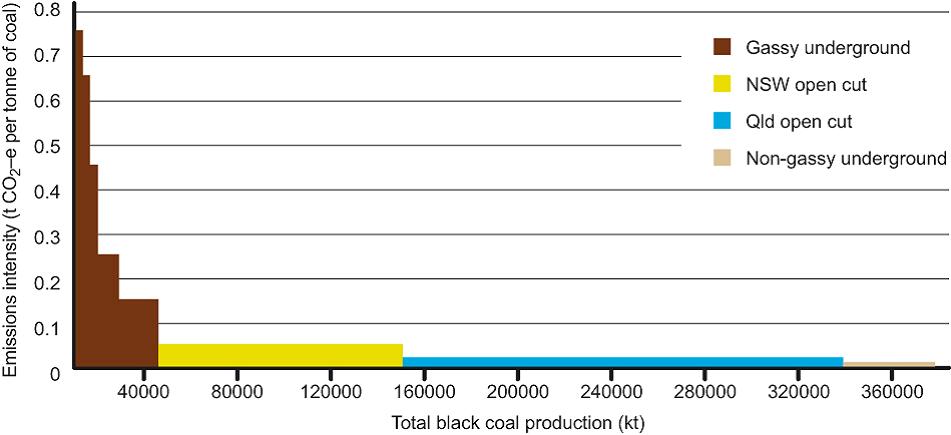When we talk about methane emissions, we tend to think about farting (or burping, more accurately) cows. But another strong contributor to methane emissions (yes, odourless and colourless like CO2) are fugitive emissions from extraction of fossil fuels, particularly coal mines. Every tonne of methane released is the equivalent of 21 tonnes of CO2 released, hence the term CO2 equivalent, or CO2e.
The Australian Coal Association (ACA) has come out with a report showing how none of their competitors put a price on “fugitive” emissions from coal mining and a report this week showing the impact of carbon pricing on their sector. They went on to call for an exemption from the carbon pricing scheme for fugitive emissions until competitors also applied such an impost to their coal industry.
Now it’s hard to find fault with the analysis of the report commissioned by the ACA and done by the CIE. It is correct that the EU ETS doesn’t include methane. For reasons best known to the Europeans, probably related to protecting local agriculture and coal mining jobs, they have chosen not to have a broad-coverage scheme as advocated here in Australia. Broad coverage means all industries and all greenhouse gases (not just carbon dioxide but also methane, nitrous oxide, sulphur hexafluoride and a range of refrigerant gases).
As the PC analysis showed last week, the narrower the policy focus of a scheme, the higher the effective abatement cost. If you leave fugitive methane from coal mines out of a scheme, then you insulate them from looking for abatement solutions, or the economic signal of favouring less gassy mines.
Although I concur with the CIE analysis, I take issues with two of ACA’s conclusions, the first being that imposing a carbon price ahead of competitors will shut down the industry locally and the second being that a charge on carbon will hit the industry hard because there are no abatement solutions.
On the first, there are a number of factors that determine whether a company invests locally versus offshore, or chooses to relocate offshore. These go to the relative merit of Australia as a country to invest in relative to other countries. Factors that determine this relative merit include the availability of skilled labour, the level of infrastructure, political stability, cost of inputs such as energy and water and the legal and regulatory framework. Carbon pricing is but one of these many factors, and it’s difficult to accept that the sole decision point on locality for future investment can be whether there’s a carbon price in place or not.
The second point is that most of the industry is not that “gassy”. Most coal mining is less than 0.1 tCO2e per tonne of coal. If a $20/t carbon price is applied, that’s less than $2/t per tonne of coal, in a market trading $200-300/tonne.
The gassy mines are a small number (20-30) of mines, typically in NSW & QLD, representing less than 10% of black coal production, but yet representing 60% of the fugitive methane emissions from the coal mining sector. This is the reason the previous government pushed back on coal industry calls for EITE treatment under the CPRS. On average, the industry did not reach the emission intensity thresholds (of tCO2e per revenue or tCO2e per value add) to qualify. However, under the CPRS, Combet put forward a $500m assistance package designed specifically to address the issue of the gassiest mines, which are the mines most vulnerable. The gassiest mines are up to 0.7t/CO2e/t coal, for which the carbon price will clearly have a more significant impact on earnings.

The ACIL Tasman analysis assumes that there are no abatement solutions, and ACA stressed this point as well. However, it’s incorrect to claim that there are no abatement solutions. The simplest abatement solution is to oxidise the methane and turn it into CO2. By combusting a tonne of methane, you save 21t CO2e and produce 2.75tCO2e in the combustion, so save 18.25tCO2e per tonne of methane combusted. The tricky thing is that the methane is usually present in such low concentrations in the ventilation air methane (VAM) stream that it won’t combust. But there are technologies available that can address this problem.
For example, BHP Illawarra has trialled and deployed a technology to oxidise the methane, called the VOCSIDISER, from a company called MEGTEC. In addition, the CSIRO have been working on an alternative abatement technology called VAMCAT. Now admittedly these technologies have not seen broad commercial deployment in Australia to date, but this is probably as a result of the lack of a carbon price. There would be a strong demand and pull through of these technologies if a carbon price was to be implemented.
Abating fugitive methane from coal mines may be one of the lowest cost forms of abatement available to industry, let alone the country, yet it won’t be deployed at large scale without a carbon price. The carbon price (to be accurate, the avoidance of the need to purchase a permit) is the sole revenue stream to justify committing the capital expenditure on this technology
This should serve as an illustration of how a carbon price works to incentivise abatement, and how exempting an industry removes a potentially low cost supply of abatement from the economy leading to then higher costs for the rest of the economy.